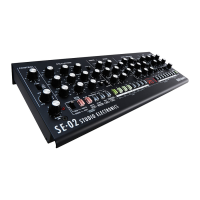IV. CV/GATE/TRIGGER
CONTROL VOLTAGE
CV/Gate is an analog method of controlling synthesizers, drum machines and other similar equipment with
external sequencers. The control voltage typically controls pitch and the gate signal controls note on-off. This
method was widely used in the epoch of analog modular synthesizers and CV/Gate music sequencers from
the mid 1970’s through the 1980s, when it was eventually superseded by the MIDI protocol. However,
companies – including Doepfer, Intellijel, Studio Electronics, Make Noise, Mutable Instruments and a growing
number of others continue to manufacture modular synthesizers that are increasingly popular and rely primarily
on analog CV/Gate signals for communication.
SE-02 uses a Volt / Octave convention, as specified initially by Robert Moog. Korg and Yamaha uses a Volt /
Hz convention, and will be incompatible with SE-02 unless uses of a Volt/Hz <> Volt / Octave converter.
CV
Here is where you connect the CV (or Pitch) from your external controller.
Example: The Arturia Keystep offers CV and Gate output. You would connect a mono 3.5mm cable between
the CV jack on the back of the SE-02 and the pitch jack of the Keystep. This allows transmission of pitch voltage
from the controller (the Keystep) to the sound source (the SE-02.) This is true of all CV/Gate enabled devices. A
vintage CSQ-600 will sequence the heck out of the SE-02 as well as a modern SQUARP Pyramid sequencer.
GATE
Here is where you connect the GATE output from your external controller.
Example:On an Arturia Keystep there is a GATE output jack beside the pitch connector. To enable the controller
to inform the SE-02 when to begin and end notes you need to connect GATE between the instruments. GATE is
the note on and note off voltage. In analog CV/Gate protocol typically 5 volts is supplied via the Gate jack in the
form of a pulse. Once received, the arrival of the pulse opens the VCA and allows sound to occur. The sound will
only occur for the duration of the GATE pulse.
VCF-CV
Here is a dedicated connector for controlling the SE-02 FILTER cutoff using CV.
Experiment: Connect the trigger out of the TR-09 drum machine to the VCF-CV input jack on the SE-02 and
program a pattern using the Trigger track. Each pulse of the trigger which arrives into the SE-02’s VCF-CV jack
will open the filter. Adjust the envelope and listen to the results. This result can also be accomplished via MIDI
using CC information, but there is an immediacy and pleasure which is derived from a direct, dedicated
connection. Try it.
CV JACK SETTINGS
The CV input jacks can be fine tuned to specify fine tune and key follow for the voltage that is input to the CV
INPUT jack.
1. Set the MODE SELECT switch to PATCH
2. Press the COMP button and PLAY button to make them light - If you decide to exit the operation, press
these buttons again to make them go dark.
3. Use the [15] - [16] buttons to select a parameter, and use the VALUE knob to edit the parameter’s
value. The display indicates the value.
BUTTON PARAMETER VALUE EXPLANATION
[15] CV Fine Tune 0-255
Finely adjusts the pitch relative to the voltage input to
the CV input jack
[16] CV Key Follow 0-255 Adjusts the width of pitch change relative to the voltage
input to the CV input jack.
NOTE: There is no need to execute the WRITE operation. CV Fine Tune and CV Key follow are saved as
settings for the entire system.
Page 29 of 35 Manual V1.03 for firmware V1.11

